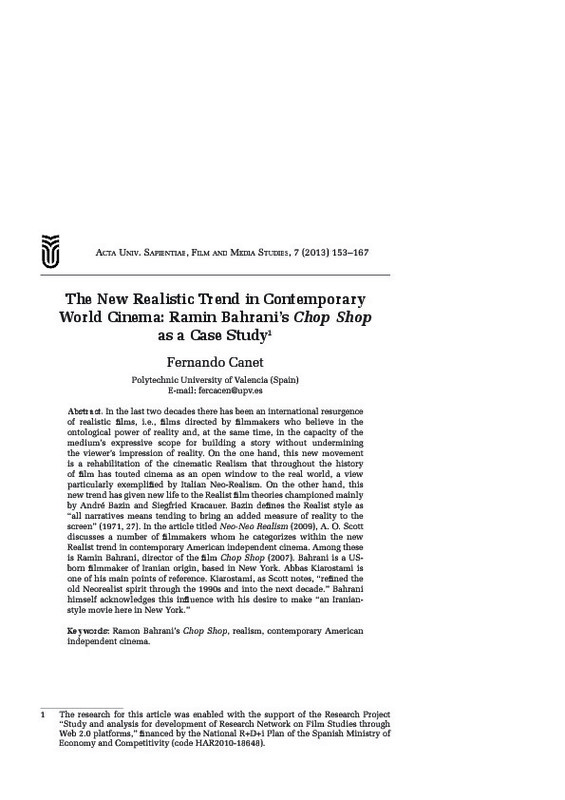JavaScript is disabled for your browser. Some features of this site may not work without it.
Buscar en RiuNet
Listar
Mi cuenta
Estadísticas
Ayuda RiuNet
Admin. UPV
The New Realistic Trend in Contemporary World Cinema: Ramin Bahrani's Chop Shop as a Case Study
Mostrar el registro sencillo del ítem
Ficheros en el ítem
| dc.contributor.author | Canet Centellas, Fernando Javier
|
es_ES |
| dc.date.accessioned | 2017-10-18T11:06:27Z | |
| dc.date.available | 2017-10-18T11:06:27Z | |
| dc.date.issued | 2013 | es_ES |
| dc.identifier.issn | 2065-5924 | es_ES |
| dc.identifier.uri | http://hdl.handle.net/10251/89408 | |
| dc.description.abstract | [EN] In the last two decades there has been an international resurgence of realistic films, i.e., films directed by filmmakers who believe in the ontological power of reality and, at the same time, in the capacity of the medium¿s expressive scope for building a story without undermining the viewer¿s impression of reality. On the one hand, this new movement is a rehabilitation of the cinematic Realism that throughout the history of film has touted cinema as an open window to the real world, a view particularly exemplified by Italian Neo-Realism. On the other hand, this new trend has given new life to the Realist film theories championed mainly by André Bazin and Siegfried Kracauer. Bazin defines the Realist style as ¿all narratives means tending to bring an added measure of reality to the screen¿ (1971, 27). In the article titled Neo-Neo Realism (2009), A. O. Scott discusses a number of filmmakers whom he categorizes within the new Realist trend in contemporary American independent cinema. Among these is Ramin Bahrani, director of the film Chop Shop (2007). Bahrani is a USborn filmmaker of Iranian origin, based in New York. Abbas Kiarostami is one of his main points of reference. Kiarostami, as Scott notes, ¿refined the old Neorealist spirit through the 1990s and into the next decade.¿ Bahrani himself acknowledges this influence with his desire to make ¿an Iranianstyle movie here in New York.¿ | es_ES |
| dc.language | Inglés | es_ES |
| dc.relation.ispartof | Acta Universitatis Sapientiae. Film & Media Studies | es_ES |
| dc.rights | Reconocimiento - No comercial - Sin obra derivada (by-nc-nd) | es_ES |
| dc.subject | Chop Shop | es_ES |
| dc.subject | Ramin Bahrani | es_ES |
| dc.subject | Contemporary cinema | es_ES |
| dc.subject | Realism | es_ES |
| dc.subject | Realist style | es_ES |
| dc.subject.classification | COMUNICACION AUDIOVISUAL Y PUBLICIDAD | es_ES |
| dc.subject.classification | BIBLIOTECONOMIA Y DOCUMENTACION | es_ES |
| dc.title | The New Realistic Trend in Contemporary World Cinema: Ramin Bahrani's Chop Shop as a Case Study | es_ES |
| dc.type | Artículo | es_ES |
| dc.identifier.doi | 10.2478/ausfm-2014-0021 | es_ES |
| dc.rights.accessRights | Abierto | es_ES |
| dc.contributor.affiliation | Universitat Politècnica de València. Departamento de Comunicación Audiovisual, Documentación e Historia del Arte - Departament de Comunicació Audiovisual, Documentació i Història de l'Art | es_ES |
| dc.description.bibliographicCitation | Canet Centellas, FJ. (2013). The New Realistic Trend in Contemporary World Cinema: Ramin Bahrani's Chop Shop as a Case Study. Acta Universitatis Sapientiae. Film & Media Studies. 7:153-167. doi:10.2478/ausfm-2014-0021 | es_ES |
| dc.description.accrualMethod | S | es_ES |
| dc.relation.publisherversion | https://doi.org/10.2478/ausfm-2014-0021 | es_ES |
| dc.description.upvformatpinicio | 153 | es_ES |
| dc.description.upvformatpfin | 167 | es_ES |
| dc.type.version | info:eu-repo/semantics/publishedVersion | es_ES |
| dc.description.volume | 7 | es_ES |
| dc.relation.pasarela | S\258448 | es_ES |








